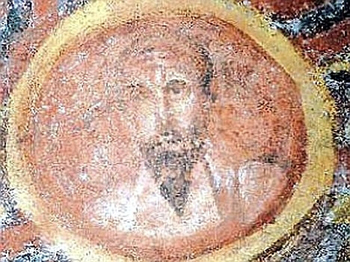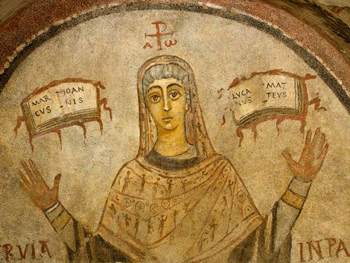Since Journey with Jesus began its 15th fiscal year on July 1, I've been thinking about what the apostle Paul wrote to the fledgling band of believers in the imperial city of Rome: "I am not ashamed of the gospel, for it is the power of God for salvation."
I've also been thinking about a fifth-century fresco of a woman named Cerula. She's dressed in elaborate priestly garb and wearing an ornate crown. She holds both hands aloft, pointing to the gospel books on each side of her head. And when you look closely, you see that those two books are exploding into flames.
When I turned sixty a few years ago, I had an ambiguous moment of self-realization — that I've gone to church almost every Sunday of my life. That’s well over three thousand services. My long term religiosity has its risks. Boredom. Cliches. Jargon. Cynicism. Merely going through the motions, however well intended.
Plus, anyone who has gone to church for sixty years and has paid attention has honest questions about complex issues. And so across the years I've accumulated my own list of critical questions. I’ve also decided to do my doubting within the community of faith, and my believing within the broader cultural conversation.
At about this same time, I began to notice something brazen at the Episcopal church that I attend every Sunday. It’s always been there, and in some form has a history as old as the gospel itself. So, it was nothing new, but for some reason it grabbed my attention, and ever since then has not let go.
 |
|
Earliest known image of Paul the Apostle, Catacombs of St. Thekla, c. 380 C.E.
|
Our Sunday service begins at the back of the church with a processional down the center aisle. First comes what’s called a verger, who leads our little line of clergy. Then there’s an acolyte who carries our local church banner, complete with red ribbons and tinkling bells. The last person in line, very much in a conspicuous pride of place, is a priest who holds high overhead a large and bright red book. These are the "exploding gospels" in the fresco of Cerula: Matthew, Mark, Luke, and John.
When they reach the front of the church, they place the red book on the altar, they bow to this book, and then sit down. After a few prayers and a hymn, there’s a reading from the Jewish “old” testament, a psalm that our choir sings a capella, and a reading from one of the epistles. There’s a lot of reading the Bible out loud in my church — a lost art in our culture, and ironically counter-intuitive when you consider that we’re a “liberal” church. Then, during the middle of the next hymn, we repeat the processional in reverse.
Once again the acolyte holds the red gospel aloft, walks back down the center aisle, and stops in the physical center of the church. The congregation turns toward the text. As the acolyte opens the book in front of her, the priest makes a tiny sign of the cross on her forehead, lips, and chest—commending her mind, her speech, and her heart to the reading of this book. She then proclaims, “the holy gospel of our Lord Jesus Christ.” The congregation responds, “Glory to you, Lord Christ.”
After she finishes reading the passage that’s assigned for that Sunday, she takes the book from the acolyte and again holds it high overhead, and then concludes, “the gospel of the Lord!” The congregation responds, “Praise to you, Lord Christ.” The priest and the acolyte then turn around and retrace their steps to the front, place the book back on the altar, and again genuflect before it.
A sermon then follows that explores what that exploding gospel story means today.
If I really want to feel the liturgical fire, I sit on the center aisle, positioned perfectly so that I could touch that text, physically closer than a comfortable psychological space between two people, and in so doing try to fathom exactly what’s going on. Except for the reading, which ricochets off the hard surfaces of the interior of the church, you could hear a pin drop.
When I watch this liturgical drama about that red book, or consider that fresco of Cerula, I want to shout, “Wait! What’s going on here? What are we saying and doing and meaning with this huge, bright red book? And why? We wouldn’t bow down to a volume of Sappho or Shakespeare, would we, however venerated?”
The public reading of the gospel invites us to reconsider, each and every Sunday, and with as much brutal honesty as we can muster, exactly what the fiery “good news” of “our Lord Jesus Christ” means, and why we don’t just salute or honor him but offer to him our praise and worship. We’re exploring over and over and over again the heart of the gospel and the core of our faith. In addition, we’re re-imagining our own selves into this ancient story, and trying to understand and shape our contemporary lives in light of it.
After the Jesuit priest John Dear met Daniel Berrigan in 1984, he asked him for a piece of advice. “Make your story fit into the story of Jesus,” said Berrigan. “Ask yourself: does your life make sense in light of the life of Jesus? All we have to do is close our eyes to the culture and open them to our friends. We have enough to go on. We can’t afford the luxury of despair.”
And so, Journey with Jesus is an invitation to a conversation. It’s an ancient conversation about the story of Jesus that has been contested from its beginnings, and always will be contested. It’s about how our contemporary stories might make sense in light of his ancient story that’s read aloud every single day in churches all over the world.
 |
|
Flaming gospel books, fifth century fresco of Cerula in San Gennaro catacomb, Naples.
|
We're confessing this Christian story in conversation with important alternative narratives. And so our webzine includes voices from Scripture, history, theology, literature, film, poetry, and personal experiences. Sometimes there are points of overlapping agreement with these alternate stories, and at other times irreconcilable differences. At nearby Stanford University, about a mile from my house, I’ve also been surprised at the profound ignorance of some otherwise very smart people about basic questions. Tired stereotypes and stale cliches are a chronic threat to clarity. Some people are so hostile to the Christian story, sometimes for good reasons, that there’s no conversation to be had with them.
David Foster Wallace once observed that we live in an environment of Total Noise. To borrow language from our engineering friends, at Journey with Jesus we're searching for the gospel signal amidst the cultural noise. We're groping for what the apostle Paul called a defense and confirmation of the story of Jesus amidst the marketplace of many other alternatives.
We're seeking a meaningful articulation of faith in a world of honest doubts, a personal confession that engages a larger public conversation. We want to move beyond sentimentality, tired cliches, and pious platitudes in order to struggle with the strange story of Jesus.
In the words of the Yale poet Christian Wiman in his book My Bright Abyss (2013), "what I crave now is some speech that is true to the transcendent nature of grace yet equal to the hard reality in which daily faith operates." We're seeking that elusive balance between "active devotion and honest modern consciousness."
NOTE: To support Journey with Jesus with a gift, please click here.
Image credits: (1) Wikipedia.org and (2) Pinterest.com.



